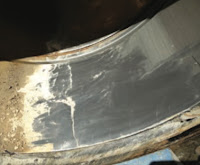Long distance slurry pipelines for moving mineral concentrates over various elevations and long distances is often more economical than trucking or rail due to topography constraints and environmental concerns. To capitalize on these investments, the pipe sizes are maximized. Therefore, large-bore dependable valves are vital to the success of the slurry pipelines.
 |
| Under the same process conditions, the competitor’s valve underperformed and required frequent maintenance due to erosion. |
Solution
Even with MOGAS’ 40-year history of successfully engineering large valves for the slurry transport market, MOGAS proposed to lease a test valve to be placed alongside a series of competitor valves.
In January 2013, a 36-inch, ASME 300 Class model CST-1 valve was installed in the first loop of the control station. In this model’s proven bi-directional seat design, the seat maintains 100% contact with the ball in both normal and reverse pressures. This prevents build-up behind the downstream seat and ensures evacuation of solids around upstream seat during cycling.
Results
 |
| After one year the MOGAS valve performed 818 successful cycles—over four times the cycle count required in this application. |
One year later during decommission, the MOGAS valve was inspected. It had performed 818 cycles; far more than the 180 cycle count required in this application. The MOGAS valve was then removed and installed outside the loop, in the main choke station replacing the competitor valve, where it further performed 215 cycles for the next two years.
After three years of continuous operation, the MOGAS valve had successfully performed 1033 cycles. On inspection, the ball and seat were in good repair, so only the gasket and packing box were replaced and the valve was put back in to service.
Download the PDF of this case study from the PSI website here.
For more information, contact Piping Specialties, Inc. by calling 800-223-1468 or visit https://psi-team.com.
Reprinted with permission from MOGAS.
